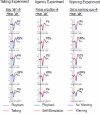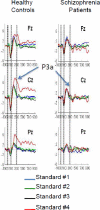Anticipating the future: automatic prediction failures in schizophrenia
- PMID: 21959054
- PMCID: PMC3288329
- DOI: 10.1016/j.ijpsycho.2011.09.004
Anticipating the future: automatic prediction failures in schizophrenia
Abstract
People with schizophrenia often misperceive sensations and misinterpret experiences, perhaps contributing to psychotic symptoms. These misperceptions and misinterpretations might result from an inability to make valid predictions about expected sensations and experiences. Healthy normal people take advantage of neural mechanisms that allow them to make predictions unconsciously, facilitating processing of expected sensations and distinguishing the expected from the unexpected. In this paper, we focus on two types of automatic, unconscious mechanisms that allow us to predict our perceptions. The first involves predictions made via innate mechanisms basic to all species in the animal kingdom - the efference copy and corollary discharge mechanisms. They accompany our voluntary movements and allow us to suppress sensations resulting from our actions. We study this during talking, and show that auditory cortical response to the speech sounds during talking is reduced compared to when they are played back. This suppression is reduced in schizophrenia, suggesting a failure to predict the sensations resulting from talking. The second mechanism involves implicitly learning what to expect from the current context of events. We study this by observing the brain's response to an unexpected repetition of an event, when a change would have been predicted. That patients have a reduced response suggests they failed to predict that it was time for a change. Both types of predictions should happen automatically and effortlessly, allowing for economic processing of expected events and orientation to unexpected ones. These prediction failures characterize the diagnosis of schizophrenia rather than reflecting specific symptoms.
Published by Elsevier B.V.
Figures





References
-
- Alain C, Bernstein LJ, Cortese F, Yu H, Zipursky RB. Deficits in automatically detecting changes in conjunction of auditory features in patients with schizophrenia. Psychophysiology. 2002;39:599–606. - PubMed
-
- Angel RW. Efference copy in the control of movement. Neurology. 1976;26:1164–1168. - PubMed
-
- Baess P, Horvath J, Jacobsen T, Schroger E. Selective suppression of self-initiated sounds in an auditory stream: An ERP study. Psychophysiology. 2011 - PubMed
-
- Barch DM, Carter CS, Braver TS, Sabb FW, MacDonald A, 3rd, Noll DC, Cohen JD. Selective deficits in prefrontal cortex function in medication-naive patients with schizophrenia. Archives of General Psychiatry. 2001;58:280–288. - PubMed
Publication types
MeSH terms
Grants and funding
LinkOut - more resources
Full Text Sources
Medical

